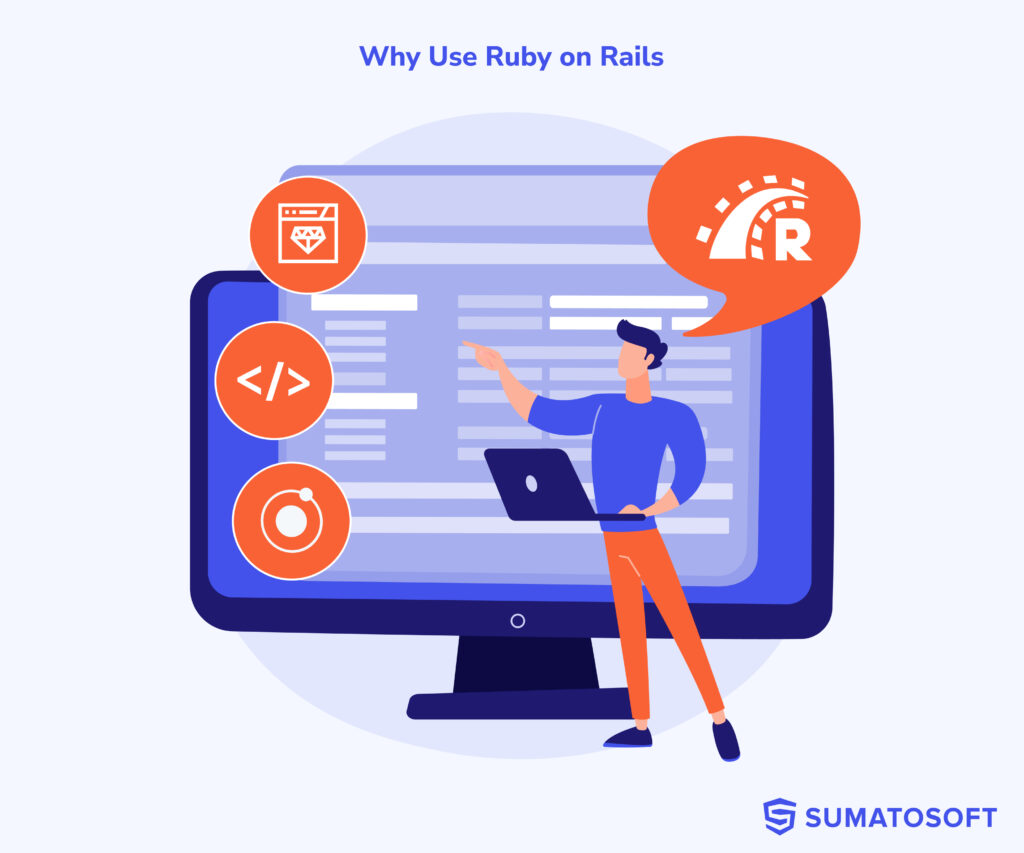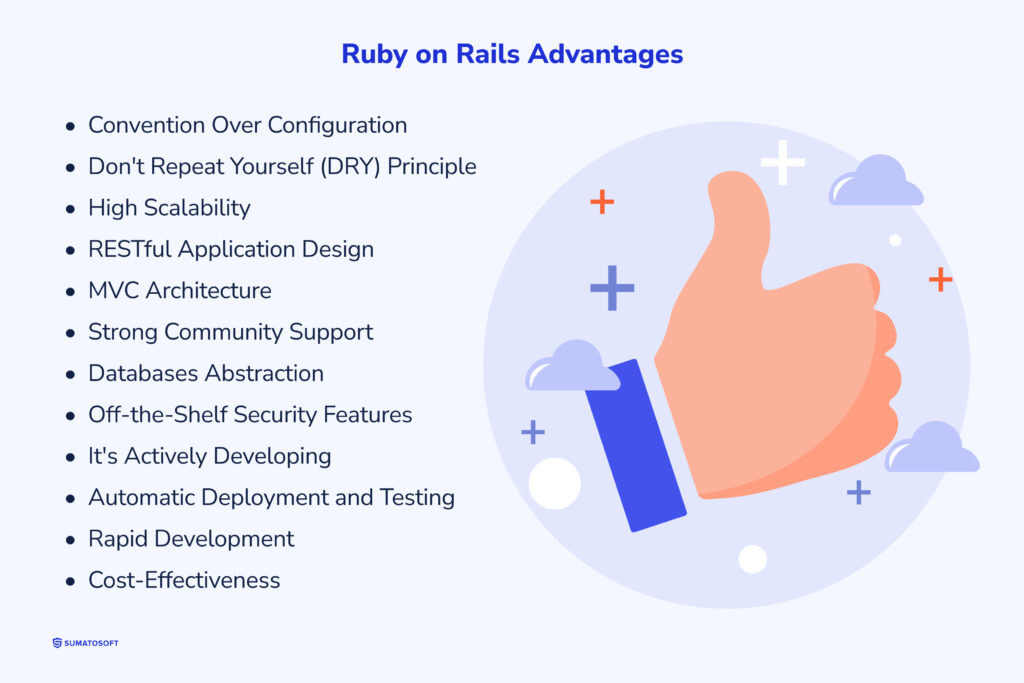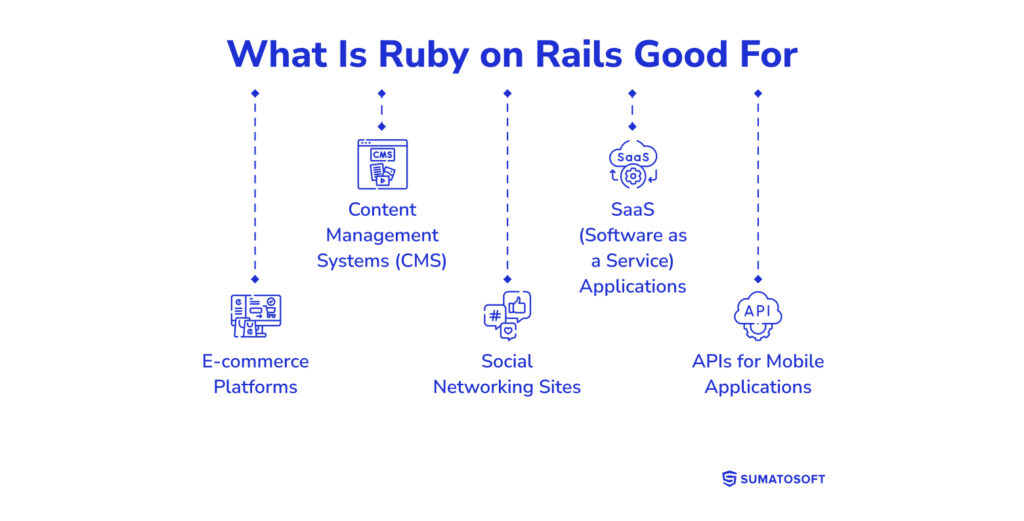Why Use Ruby on Rails: Advantages and Usage Examples


Are Ruby and Ruby on Rails dead?
Is Ruby slow?
These concerns are prevalent among businesses and developers when they consider implementing Ruby at the beginning of the project. Nowadays, these concerns have nothing to do with reality, and 300.000 professional Ruby programmers across the world prove it by developing high-performance applications like Airbnb, Kickstarter, GitHub, and more. This article aims to shed light on Ruby’s strengths and weaknesses, particularly through its popular framework, Ruby on Rails (RoR). I’ll try to answer the question of whether RoR is still relevant in the modern technological landscape.
Ruby on Rails (or simply RoR or Rails) is a server-side web application framework written in Ruby programming language. It simplifies the web development process by providing a well-organized structure for the code. This means several things, which I will describe in detail later:
- RoR provides Model-View-Controller (MVC) architecture;
- RoR uses convention over configuration (CoC);
- RoR uses an active record pattern;
- RoR has a vast library of gems
All these with one purpose in mind: to simplify and streamline the process of software development. RoR does a great job with this, allowing to build various types of web applications, from simple prototypes to complex, high-traffic platforms. Here are some of the most prominent examples.
Famous Companies That Use Ruby on Rails
- GitHub;
- Shopify;
- Airbnb;
- Twitch;
- SoundCloud;
- Basecamp;
- Square;
- Hulu;
- Zendesk;
- Twitter.
Is Ruby and Ruby on Rails the Same
To put it simply, no, Ruby and Ruby on Rails are not the same, though they are closely related. Ruby is a programming language, while Ruby on Rails is a web application framework that is written in Ruby. It uses Ruby as its programming language but extends its capabilities with libraries, conventions, and tools specifically aimed at web development.
Inheritance From Ruby
Even though Ruby and RoR are not the same technologies, RoR inherits a lot of great things from Ruby. Like what?
Object-Oriented Nature
Rails leverage Ruby’s object-oriented nature to define models, controllers, and other components using classes and modules.
Dynamic Typing and Duck Typing
Another great inheritance from Ruby is Ruby’s dynamic typing which allows Rails to handle variables and objects flexibly without needing explicit type declarations. Duck typing, in turn, shifts focus from the object’s class to its methods. If an object behaves like a certain type (by having the appropriate methods), it can be used as that type regarding its class.
Metaprogramming
Rails uses Ruby’s metaprogramming capabilities to create internal DSLs to define routes, validations, and associations in a concise and readable manner.
Syntax
Rails leverages Ruby’s elegant and expressive syntax to create just beautiful and easily readable codes. It includes aspects such as natural language constructs (Ruby code resembles natural language), consistent naming conventions (Ruby encourages the use of descriptive names), minimal punctuation, the Don’t repeat Yourself principle, and more.
What about the negative traits of Ruby? Let’s talk about the two most popular of them.
Negative Traits of Ruby: Reality or Myth?
Historically, the are two major arguments when criticising Ruby:
- Ruby is slow;
- Ruby-based projects lack scaling opportunities.
This was true in the early versions of the Rails framework, which indeed lagged behind its contemporaries, such as PHP or Python, in terms of performance and scalability.
Today, ongoing improvements in the language and frameworks, as well as scaling and performance optimization techniques like caching, database indexing, query optimization, and the use of services like AWS, Heroku, etc., have mitigated many of these concerns.
Today, any performance issues in Ruby applications are more likely attributable to the architecture of the application itself or the developers’ proficiency with the language rather than inherent flaws in Ruby or Rails.
Difference Between Ruby and Ruby on Rails
| Feature | Ruby | Ruby on Rails |
| Type | Programming Language | Web Application Framework |
| Purpose | General-purpose programming, including web, system utilities, scripting | Specifically designed for developing database-backed web applications |
| Development Focus | Broad | Web development |
| Principles | Convention over Configuration (CoC), DRY (Don’t Repeat Yourself), and MVC (Model-View-Controller) pattern | Convention over Configuration (CoC), DRY (Don’t Repeat Yourself), and MVC (Model-View-Controller) pattern |
| Community & Ecosystem | Diverse, including different fields of software development | Primarily focused on web development, with a vast library of gems for extending functionality |
| Learning Curve | Relatively straightforward, with a focus on language syntax and object-oriented programming concepts | Steeper, requires understanding of Ruby plus web development practices and architectural patterns |
| Use Cases | Versatile usage across different domains beyond the web | Tailored for building scalable and maintainable web applications quickly and efficiently |
How Does Ruby on Rails Work
In simple terms, Ruby on Rails works like a well-oiled machine, designed to make a developer’s life easier and more efficient. It’s built on a smart setup called the Model-View-Controller (MVC) architecture, which basically splits the work into three interconnected parts.
- First, there’s the Model, which is responsible for the data and the business logic. It manages the rules of how data can be accessed and modified, interacts with the database, and defines methods to handle the user data.
- Then, we have the Views. This part is what users see and interact with. It’s the website’s design, the buttons, and the text. Views are responsible for displaying the data from the model to the user and then sending the user commands to the controller, which is our last element.
- The Controller is the middleman. It takes requests from the users (through the Views), decides what to do with them, and then talks to the Model to get the necessary data. So, the controller acts as an intermediary between the model and the view.
Rails also love keeping things straightforward with its “Convention Over Configuration” motto. This means developers don’t have to spend ages setting things up. If they follow the standard Rails conventions, many things work right out of the box.
In essence, Ruby on Rails takes a lot of the tedious, repetitive work off hands, allowing developers to build web applications more quickly and with fewer bugs. It’s like having a helpful assistant who knows exactly what a Rails developer needs! And that’s why Ruby on Rails is so good.
What Are Ruby on Rails Advantages

I’ve already highlighted some of the great features of Rails. Still, there is more to be said. Rails encompasses a lot of powerful features and principles designed to make development easier, enjoyable, and efficient. Here are the core features that RoR developers like in this framework.
Convention Over Configuration
Convention Over Configuration is a software design principle supposed to minimize the amount of decision-making and configuration required by developers. Its idea is to provide valuable defaults for project structure, naming conventions, and settings so developers can focus on the business logic of the application rather than dealing with some minor formal setup tasks. This principle covers such aspects of software development as:
- where to place files;
- how to name classes;
- how to connect different components;
- default behaviors and settings;
- automatic mapping;
- automatic connection of models to database tables based on naming conventions.
Don’t Repeat Yourself (DRY) Principle
The DRY principle implies the minimization of code duplication. It encourages developers to abstract repeated logic and ensure that every piece of logic is represented only once in the codebase. In Ruby on Rails, this can be achieved through the use of partials, helpers, modules, and concerns.
High Scalability
As I’ve mentioned, Ruby and RoR have historically been criticized for their scalability. However, much work has been done to address this concern. Caching methods like page, fragment, and low-level cashing, as well as database optimization, offloading long-running tasks to background job processors like Sidekiq, Resque, or Delayed Job, asynchronous processing, microservice architecture, use of content delivery network to serve static assets, and more have made a great contribution to making RoR applications scale effectively.
MVC Architecture
MVC architecture is a great enhancement for any application because it improves the development process and overall quality of the software. From the developer’s perspective, MVC architecture makes the code easier to write, manage, and maintain by splitting the application into 3 components: Model, View, and Controller. This division helps to effectively organize the code, reuse components, easily scale the application by adding new models, views, or controllers, and test each component independently to achieve better test coverage and more.
From a business perspective, this separation accelerates feature development, reduces costs for updates and scaling up, and implies less maintenance efforts. For example, if a business decides to update the application UI, the MVC architecture allows changes to be made only for the View component without touching and altering the business logic and Controller.
Strong Community Support
The Ruby on Rails community is one of its greatest strengths, characterized by:
- over 5,000 contributors to the Rails source code;
- more than 150,000 libraries (gems) available, extending functionality and reducing development time;
- a global network of Ruby on Rails web developers and companies sharing knowledge, which translates to quicker problem-solving and innovation;
That means businesses aren’t locked into proprietary solutions from specific vendors.
Databases Abstraction
When working with a database such as Postgresql, Active Record (ORM used by Ruby on Rails) allows you to abstract from the current database at higher levels. This makes it possible to write almost the same code for any supported database.
The framework works with all popular SQL databases, so you can focus on the implementation of business tasks rather than writing a huge number of low-level SQL commands.
So, no need for a specialized database administrator for routine tasks because they can be done on a higher level.
Off-the-Shelf Security Features
Rails takes security seriously, offering built-in mechanisms to protect against common threats like SQL injection and XSS attacks:
- active Record sanitizes SQL queries automatically.
- Cross-site scripting (XSS) sanitizes helpers and Content Security Policy (CSP) integration.
So businesses have a reduced risk of data breaches which is always a good thing nowadays. For example, the strong_parameters feature ensures only permitted attributes can be updated through web forms. Here is Ruby on Rails code:
class UsersController < ApplicationController
def create
@user = User.new(user_params)
# Additional logic to save @user
end
private
def user_params
params.require(:user).permit(:username, :email)
end
end
It’s Actively Developing
Ruby on Rails continues to evolve with regular major and minor releases. It is an open-source solution with a vibrant and large community of developers who contribute through open-source projects, plugins (gems), and extensive documentation.
The rails team aims to release a new major version approximately every two years that includes significant performance improvements, security enhancements, and new features or integrations.
There are also minor releases every six months that include minor improvements and the introduction of small features.
And finally, patches. These are regular releases that fix bugs and security vulnerabilities.
Automatic Deployment and Testing
Rails simplifies deployment and testing in multiple ways:
First, it’s Capistrano – an automated deployment tool that supports scriptable deployments.
Then, built-in test frameworks such as MiniTest and RSpec integration. They facilitate behavior-driven development (BDD) and test-driven development (TDD) methodologies.
For instance, a project utilizing continuous integration and deployment tools, along with Rails’ testing frameworks, can automate much of the testing and deployment pipeline. That means that new features can be developed, tested, and released rapidly, allowing businesses to respond to any market changes by quickly introducing new relevant features.
Rapid Development
Rapid development in Ruby on Rails isn’t just an isolated advantage; it’s the cumulative result of leveraging the framework’s array of built-in features and philosophies. Each element of Rails, from its Convention over Configuration paradigm, through the efficient MVC architecture, to the comprehensive ecosystem of gems, contributes to the rapid development.
Collectively, these aspects of Rails reduce programming timelines, allowing businesses to adapt to market changes swiftly, iterate on user feedback, and maintain a competitive edge by rapidly bringing new ideas to market.
Cost-Effectiveness
Finally, all the factors above lead to one simple conclusion: Ruby helps to cut costs of development from scratch, introducing new features, and maintaining the existing product. And this is an awesome and impressive advantage.
What Is Ruby on Rails Good For

You can build literally anything with the Ruby on Rails framework. Well, I personally did it.
Still, here is some Ruby on Rails usage examples where this technology is an obvious choice:
ECommerce Platforms
Rails provides several opportunities from which any eCommerce platform can benefit. They include rapid development from scratch, quick introduction of new features based on market demands and user feedback, robust libraries for handling payments, user authentication, and product management, and great scalability options to handle the increased traffic during peak demands. Shopify, an eCommerce platform, is built on Rails.
Content Management Systems (CMS)
For CMS, Rails offers efficient handling of large volumes of content, SEO-friendly architecture, code modularity and reusability. There are multiple blogging platforms, news websites, and digital magazines built on Rails.
Social Networking Sites
The framework’s capability to handle large volumes of data and traffic makes it a good fit for social networking sites. Rails facilitates the development of features like feeds, friend networks, and messaging systems with ease. Twitter was originally built on Rails.
Scalable Learning Management Systems (LMS)
Ruby on Rails enables rapid development and scalability, which is crucial for creating and expanding learning management systems (LMS), online course platforms, and student management tools. There are numerous relevant educational libraries for user authentication, content management, and interactive elements.
SaaS (Software as a Service) Applications
Rails are a popular choice for building SaaS applications due to their modular design. This design supports the development of multi-tenant applications (where a single instance of the software serves multiple customers). Moreover, Rails’s robust security features and efficient request handling are crucial for the SaaS model.
APIs for Mobile Applications
Rails is also an excellent backend solution for mobile applications thanks to it scalable API layer. Rails support for RESTful architecture means developers can create APIs that enable seamless communication between the mobile front end and Ruby on Rails backend development. So, that’s a big advantage of Ruby on Rails.
How I Mastered Ruby on Rails in SumatoSoft
SumatoSoft is a software development service provider that has become a technological partner to its Clients across 27 countries. Our portfolio includes over 250 successful projects in various industries, such as eCommerce app development, Elearning software, Finance, Real Estate, Logistics software development, Travel, and more.
The company delivers exemplary services in 12+ business domains and works with all types of technologies like the Internet of Things, Big Data, Blockchain, Artificial Intelligence, Machine Learning, web, mobile, and progressive app development. However, our key areas of expertise are Ruby on Rails development and development of the Internet of Things. So, we can be considered as Ruby on Rails web development company.
We mastered Ruby on Rails working on projects like:
- the user interfaces for robot operation;
- custom ERP system for Toyota car dealer;
- big data trading platform.
And dozens of other projects. We also enjoy writing about Ruby on Rails technology and know its usage, pitfalls, and benefits of Ruby on Rails. Look at our blog articles:
- Build Your Live-Streaming Service with Ruby on Rails and TokBox.
- Ruby on Rails for Startups: Birds of a Feather.
- Why use Ruby on Rails for Your Software Development Project.
- 15+ Best Sources to Hire Ruby on Rails Developers for Your Project.
We can make a massive contribution to the development of complex projects. Contact us if you are looking for high-level technical expertise.
The Bottom Line
Ruby on Rails stands out as a versatile and powerful framework that excels in rapid prototype development, making it a prime choice for startups and projects aiming for quick market entry.
Key to Rails’ appeal are its Convention over Configuration and DRY principles, which streamline development processes, enhance security, and ensure scalability. This framework provides a solid foundation for developing web applications that require quick iteration, reliable performance, and the ability to grow with user demands, positioning Ruby on Rails as a go-to solution for a diverse range of web development projects.
Our company can help you implement your ideas and create high-quality web projects in a short time and with decent technical support.
Let’s start
If you have any questions, email us info@sumatosoft.com




